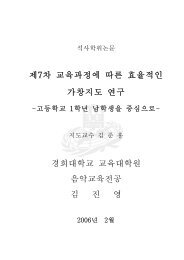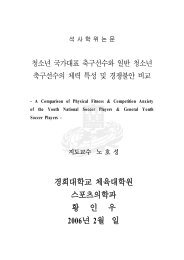경희대학교 동서의학대학원 의 학 영 양 학 과 김 선 아
경희대학교 동서의학대학원 의 학 영 양 학 과 김 선 아
경희대학교 동서의학대학원 의 학 영 양 학 과 김 선 아
Create successful ePaper yourself
Turn your PDF publications into a flip-book with our unique Google optimized e-Paper software.
Figure 3. The intramolecular and intermolecular cross-links of collagen<br />
One can visualize the ultrastructure of collagen by thinking of the individual<br />
molecules as a piece of sewing thread. Many of these threads are wrapped<br />
around one another to form a string (fibrils). These strings then form cords;<br />
the cords associate to form a rope, and the ropes interact to form cables.<br />
The structure is just like the steel rope cables on the Golden Gate bridge.<br />
This highly organized structure is what is responsible for the strength of<br />
tendons, ligaments, bones, and dermis.<br />
When the normal collagen in our tissues is injured and replaced by scar<br />
collagen, the connective tissue does not regain this highly organized<br />
structure. That is why scar collagen is always weaker than the original<br />
collagen. The maximum regain in tensile strength of scar collagen is about<br />
70 to 80 percent of the original.(Schilling JA. Wound healing. 1968) Collagen<br />
- 22 -

















